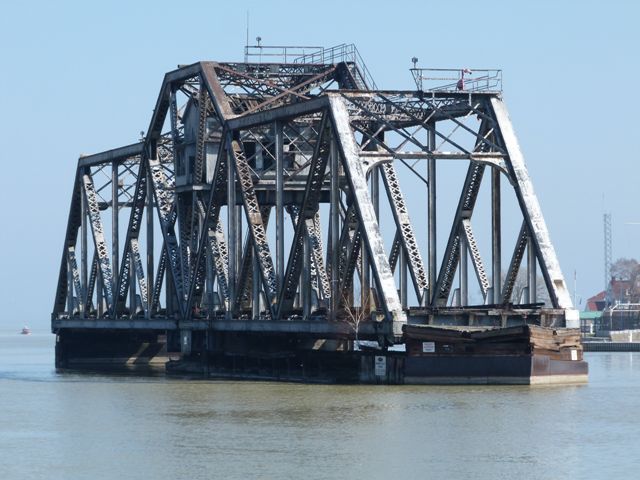We Recommend:
Bach Steel - Experts at historic truss bridge restoration.
BridgeHunter.com Phase 1 is released to the public! - Visit Now
Hojack Swing Bridge

Primary Photographer(s): Nathan Holth
Bridge Documented: March 22, 2012
Rochester: Monroe County, New York: United States
1905 By Builder/Contractor: King Bridge Company of Cleveland, Ohio
Not Available or Not Applicable
304.0 Feet (92.7 Meters)
Not Available
Not Available
1 Main Span(s)
Not Applicable

View Information About HSR Ratings
Bridge Documentation
This bridge no longer exists!
This historic bridge was demolished November 2012!
View Documentation Related To The Section 106 Process For This Historic Bridge
View A Website Dedicated To Saving This Historic Bridge
This bridge is an impressive railroad swing bridge. It is noteworthy as one of the few known surviving swing bridges associated with the noteworthy and prolific King Bridge Company. It was built in 1905 to serve the New York Central and Hudson River Railroad and most recently served CSX Railroad.
This is a railroad bridge that has been abandoned in its open position since 1994. This bridge is slated for demolition, largely thanks to the U.S. Coast Guard which has demanded the demolition of this bridge for years, without giving fair consideration to the historic value of the bridge and community support for preserving the bridge. For years, preservationists have fought to keep this bridge standing, and avoid demolition. The bridge is not in the way of any replacement structure. It is not in danger of collapse, and in fact the Section 106 process revealed that the bridge was in "excellent" condition.
The U.S. Coast guard has a dysfunctional and wasteful policy that states that the Coast Guard will seek the demolition of any bridge over waterways it has jurisdiction over if said bridge is not "functioning as a bridge" which essentially includes abandoned bridges. This policy is dysfunctional and wasteful because it does not take into account the value of historic bridges, even those historic bridges not open to traffic. There is value and purpose to leaving such bridges standing. The Coast Guard claims that the bridge is an obstruction to navigation. However, this bridge has been standing for over a century. If it truly were an obstruction it would have been replaced long ago. There have been no recent changes in size or quantity of boats on this waterway. In fact, the bridge may serve to calm the speed of recreational craft roaring into the river off of the Lake.
Another issue supposedly hindering preservation was the possible presence of asbestos on the bridge. Such materials would be isolated, and confined to things like the bridge tender house. These items could be removed from the bridge. The metal trusses themselves, the historically significant part of the bridge, are made of steel, not asbestos. Also, asbestos would have to be abated during demolition anyway, so this is no more a barrier to preservation than to demolition.
The story of this bridge could have been improved if the bridge were relocated to a new location, even if set on land as a non-functional exhibit. This would remove the bridge from the water, eliminating the perceived navigational obstruction, while also preserving the historically significant trusses. Perhaps moved onto land as a non-functional exhibit might even be nicer, since people could walk up to the bridge and see it up close. However, the current plan failed to even save the bridge in this manner. The shortsighted and wasteful decision of demolition will reduce this historic bridge "in excellent condition" to nothing more than a pile of scrap metal.
![]()
Photo Galleries and Videos: Hojack Swing Bridge
Bridge Photo-Documentation
Original / Full Size PhotosA collection of overview and detail photos. This gallery offers photos in the highest available resolution and file size in a touch-friendly popup viewer.
Alternatively, Browse Without Using Viewer
![]()
Bridge Photo-Documentation
Mobile Optimized PhotosA collection of overview and detail photos. This gallery features data-friendly, fast-loading photos in a touch-friendly popup viewer.
Alternatively, Browse Without Using Viewer
![]()
Maps and Links: Hojack Swing Bridge
This historic bridge has been demolished. This map is shown for reference purposes only.
Coordinates (Latitude, Longitude):
Search For Additional Bridge Listings:
Bridgehunter.com: View listed bridges within 0.5 miles (0.8 kilometers) of this bridge.
Bridgehunter.com: View listed bridges within 10 miles (16 kilometers) of this bridge.
Additional Maps:
Google Streetview (If Available)
GeoHack (Additional Links and Coordinates)
Apple Maps (Via DuckDuckGo Search)
Apple Maps (Apple devices only)
Android: Open Location In Your Map or GPS App
Flickr Gallery (Find Nearby Photos)
Wikimedia Commons (Find Nearby Photos)
Directions Via Sygic For Android
Directions Via Sygic For iOS and Android Dolphin Browser
USGS National Map (United States Only)
Historical USGS Topo Maps (United States Only)
Historic Aerials (United States Only)
CalTopo Maps (United States Only)

